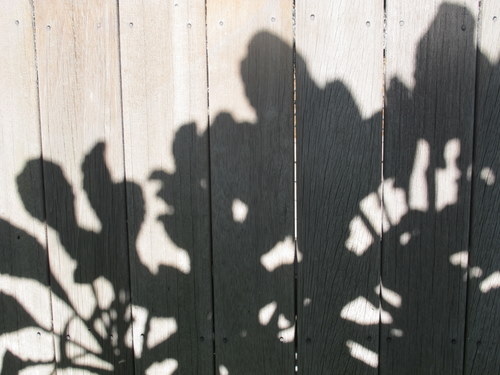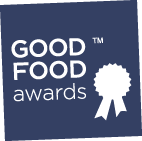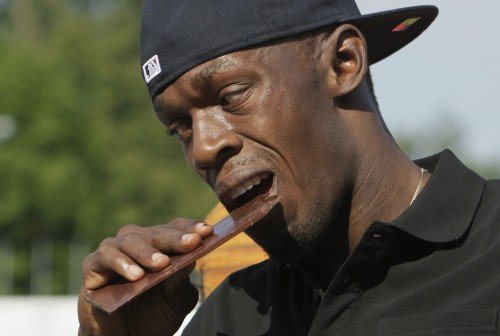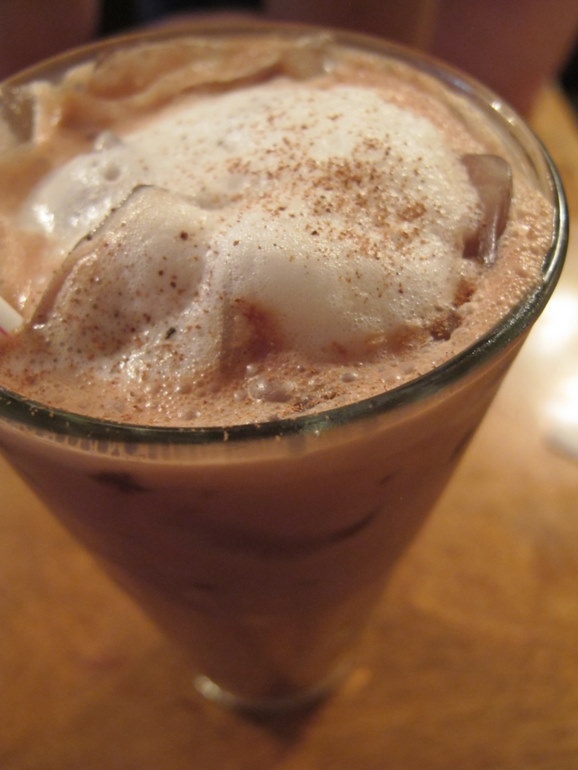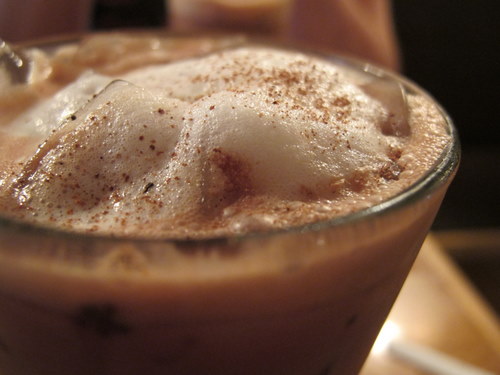7 Gift Ideas For the Chocolate Lover
Wondering what to gift the serious chocophile in your life? Here are 7 ideas for the holiday season.
1. Cocoa Pods
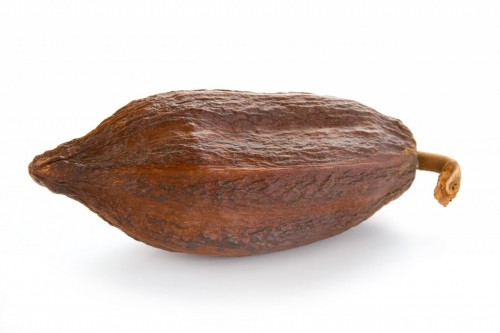
[Photograph: The Cocoa Pod shop]
Cocoa pods make for interesting home decor conversation pieces. The Cocoa Pod shop currently sells whole dried cocoa pods and open empty dried cocoa pods collected directly from cocoa growers in Ecuador.
Cost: $13.95 each + shipping.
2. Hot Chocolate Making Kit
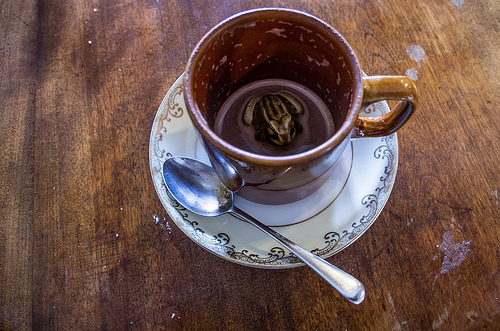
[Photograph: Graeme Pow]
Perhaps the most satisfying hot chocolate is made at home on the stovetop by melting fine chocolate into water or milk (or cream!). A hot chocolate making kit could include some or all of the following:
- a good quantity of good quality chocolate, preferably pre-chopped or in small pieces for easy prep: e.g. Michel Cluizel mini-grammes or Valrhona feves;
- luxurious cups: There are countless options for serving cups at a wide variety of price points. Lately I find myself most enjoying hot chocolate in a demitasse espresso cup, which is just the right size for a reasonable serving. In the splurge category, check out these classy cup brands that come recommended by coffee professional Meister at Serious Eats: Ancap and NotNeutral.;
- an immersion blender or milk frother;
- spices and extracts;
- recipes: from books (e.g. Michael Turback’s Hot Chocolate or, for a Francophile, Jean-Paul Hévin’s Chocolat Chaud) or the web (e.g. Paul Young’s Aztec Hot Chocolate, Maricel Presilla’s Hot Chocolate Agasajo, Hot Chocolate with Máchica).
Cost: Choose your own adventure.
3. Historical Chocolate Artifacts
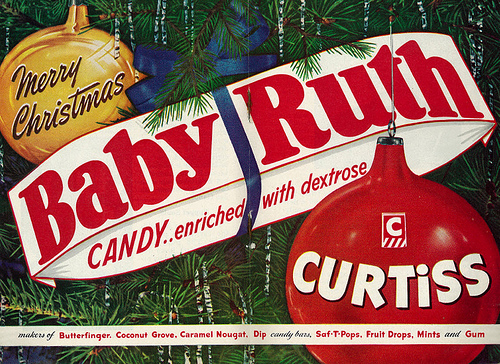
[Photograph: classic_film]
If you enjoy the thrill of the search, there is a world of fun to be had in finding historical chocolate artifacts like vintage advertisements, antique chocolate pots and serving sets, or rare books on cacao and chocolate. Online, start with Ebay, Etsy, and Google to get the lay of the land. Offline, try antique shops, flea markets, rare or used book stores, and estate auctions. (Confession: I routinely search for “mancerina” on Ebay and occasionally unearth a pricey, centuries-old item. I then covet it daily via an open tab in Google Chrome, wondering who might buy it, only to watch the auction expire. Gorgeous mancerina-of-the-moment, I dream of adopting you one day!) Rest assured that a historical chocolate artifact is a gift to be remembered.
Cost: From pennies to thousands of dollars, beware all your moneys fleeing your wallet!
4. Books
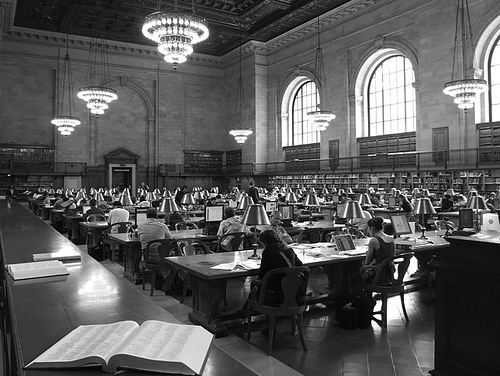
[Photograph: manyhighways]
Every chocolate lover needs to read at least two books: Maricel Presilla’s The New Taste of Chocolate: A Cultural & Natural History of Cacao with Recipes and Sophie D. Coe and Michael D. Coe’s The True History of Chocolate. Beyond that, one could read for years and never come close to finishing the literature on chocolate. See here for my favorite books on chocolate from 2012 and 2011.
Cost: Usually between $10 to $30 each.
5. Chocolate money
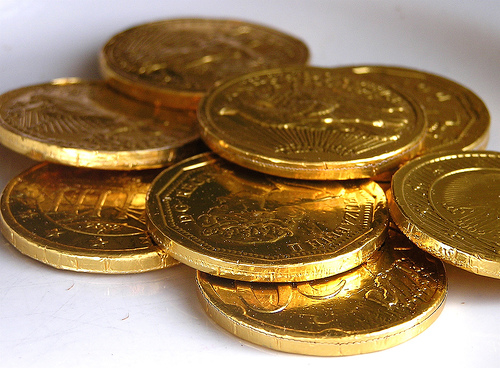
[Photograph: Muffet]
Exploring the world of fine chocolate requires financial investment; a gift certificate to an excellent chocolate shop will help your giftee take their chocolate love to the next level. Below are links to a few of my favorite North American specialty chocolate shops offering gift certificates. You can’t go wrong with any of these, though I also strongly recommend supporting local specialty shops in your area:
- Chocosphere gift certificate (web based)
- Cacao Portland gift certificate (Portland, OR)
- Formaggio Kitchen gift certificate (web and Cambridge and Boston, MA, New York, NY)
- Future Chocolate at The Chocolate Garage (web and Palo Alto, CA)
- Chocolopolis gift card (web and Seattle, WA)
- The Meadow gift certificate (web and New York, NY, Portland, OR)
Cost: Ranges from $25 to $500.
6. Good Food Awards Finalists
[Image: Good Food Awards]
The Good Food Awards 2014 finalists, announced in November, represent a unique group of American artisan food producers. Let your chocolate giftees judge the products for themselves by providing a sampling of the finalists in the chocolate and confections categories (note: not all confections are chocolatey). Winners, chosen from the group of finalists, will be announced in January 2014.
Cost: It’s up to you.
7. Online learning
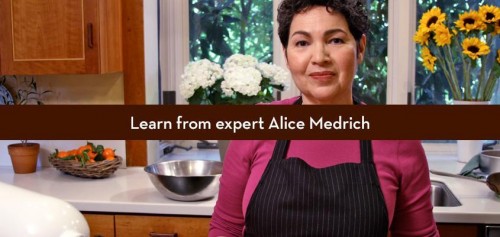
[Photograph: Craftsy]
The popular e-learning site Craftsy currently has a Decadent Chocolate Cakes class on offer, taught by renowned chocolate dessert chef and cookbook author Alice Medrich. The offering includes 10 HD video lessons, downloadable class materials, and a virtual classroom that will help your giftee learn how to make three elaborate chocolate cakes.
Cost: $29.99.
Chocolate Books of 2012
While 2011 was a busy year for publishing on chocolate (see last year’s summary list here), 2012 ushered in a dizzying array of chocolate-related books from multiple genres. Below, you’ll find my picks for several of the best, as well as some from my to-read list.
If there are other recently published books that you don’t see listed here, I would love to hear your recommendations.
Note: It is the case with many of the chocolate cookbooks listed below that they will teach you surprisingly little about cacao and chocolate (and some of it will even be wrong). By all means, get chocolate-centric cookbooks for the recipes and inspiration, then couple them with a text that focuses on source ingredients cacao and chocolate like Presilla’s The New Taste of Chocolate: A Cultural & Natural History of Cacao with Recipes for a more meaningful introduction to the topic.
Happy reading!
Cookbooks/Technique books
Gran Cocina Latina: The Food of Latin America
2012 brought us another masterpiece from award-winning chef and scholar Maricel Presilla — Gran Cocina Latina. This cookbook, with more than 500 carefully researched recipes from Latin America, spans the genres of culinary history and ethnography. An entire section of the book is devoted to cacao and chocolate. It is of interest to chefs, home cooks, food travelers, and scholars.
The Elements of Dessert
A must read for hardcore pastry and cooking science geeks, this beautiful cookbook from celebrated pastry chef Francisco Migoya has over 200 recipes for exquisite, elaborate modern desserts.
Chocolates and Confections: Formula, Theory, and Technique for the Artisan Confectioner
This text is a standard for pastry chefs, bakers, and chocolatiers, now in its second edition. It has been significantly expanded and revised to include new recipes, formulas, and business advising sections.
Bouchon Bakery
This book has been everywhere this year — prominently displayed in bookstores, on several “best of” lists, and occasionally even selling out on Amazon. The praise is well-deserved, as the recipes, mixed with fun anecdotes from Keller, are instructive and scrumptious. The photography and design make the book worthy of coffee table fame, if you can tolerate the looking without cooking.
The Blue Bottle Craft of Coffee: Growing, Roasting, and Drinking, with Recipes
A book not about chocolate, but another celebrated bean — coffee. This is an excellent, instructive text that takes the reader from coffee plant to tastebud. To the best of my knowledge, a similar book does not exist in the craft chocolate world (Presilla’s comes closest, perhaps), but one should.
Original 1896 Boston Cooking-School Cook Book
A reprint of an American classic, of interest and use for almost all home kitchens. Historical chocolate recipes, too!
Professional Baking
The sixth edition of a canonical educational text on baking.
Sugar and Spice: Sweets and Treats from Around the World
Gaitri Pagrach-Chandra is an award-winning food historian and writer. In this text, she has collected over 120 clear recipes for sweet treats from around the world. Stories and images make this book equal parts good read and useful cookbook.
The Liddabit Sweets Candy Cookbook: How to Make Truly Scrumptious Candy in Your Own Kitchen!
For DIY enthusiasts and candy lovers, this cookbook from the popular Liddabit Sweets brand clearly explains home candymaking with fun flavor twists. The photos are lovely and instructive, and the authors’ humor is entertaining.
Luscious Chocolate Desserts
For the reader who wants alluring pictures and mouthwatering, well-tested chocolate recipes designed for home cooks, this cookbook from Lori Longbotham, a former food editor at Gourmet, does not disappoint. 65-plus recipes, clear instructions, and easily-located ingredients make this ideal for someone obsessed with chocolate but new to cooking with it.
I’m Dreaming of a Chocolate Christmas
Award-winning chef and pastry chef Marcel Desaulniers provides 72 delectable chocolate Christmas recipes for home cooks. Includes a section on packing and shipping treats as gifts.
Rococo: Mastering the Art of Chocolate, Chantal Coady
Rococo is an elegantly branded product line from one of Britain’s top chocolatiers, Chantal Coady. In this exquisitely designed book, Coady tells the story of her business and provides a selection of plainly written recipes. Also great for display and gifting.
Chocolate to Savour, Kirsten Tibballs
Kirsten Tibballs, Australian chocolatier, pastry chef, Callebaut representative, and founder of the Savour Chocolate and Patisserie School in Melbourne, offers plainly written recipes for enthusiasts in this debut cookbook.
Patrick Roger, en quète de chocolat, Patrick Roger, Jean-Marc Dimanche
Eccentric French chocolatier Patrick Roger has here collected stunning photographs of some of his most celebrated chocolate sculptures, from an exhibit series that illustrates the dangers of deforestation to animals. These remarkable works of chocolate art feature orangutans, gorillas, polar bears, elephants, and more. In French.
Chocolat Café, Pierre Marcolini
Belgian chocolatier Pierre Marcolini has produced a cookbook that brings together chocolate and coffee. The text has recipes, photos, advice on chocolate and coffee pairing, and stories from Marcolini’s life. In French.
Chocolat, Christophe Felder, Domitille Langot
Noted French pastry chef Christophe Felder’s enormous cookbook has approximately 200 recipes for chocolate and pastry, ranging from simple to challenging, traditional to innovative. Felder offers advice on tasting, flavor pairing, and working with chocolate. A good fit for pastry chefs and adventurous home cooks. In French.
Chocolat Menier, Vincent Boué, Hubert Delorme, Didier Stéphan, Héloïse Martel
This cookbook is the stuff of nostalgia for any who grew up eating Menier chocolate. Nearly 300 easy-to-make classic recipes for the home cook. In French.
Nonfiction
Raising the Bar: The Future of Fine Chocolate
Author, entrepreneur, and educator Pam Williams has long been a leader in the chocolate industry. (Regular readers will note that I took an online course at her school, the Ecole Chocolat.) Jim Eber, her co-author, is a specialist in food and business marketing. In this important text, they survey the current state of the chocolate industry — from cacao genetics to farms to marketing to the art of the chocolatier. A must-read for the serious chocolate geek.
Chocolate Islands: Cocoa, Slavery, and Colonial Africa
This travel narrative from historian Catherine Higgs traces the travels of Englishman Joseph Burtt, hired by Cadbury Brothers Limited to investigate claims of forced labor on the cacao plantations of Sao Tome and Principe, through Africa. Burtt’s early twentieth century “fieldwork experience” of sorts, and subsequent slow, but deliberate reporting on the abuses he witnessed played a role in influencing a number of important changes in African labor practices and chocolate industry ethics. (This history is detailed in different form in Lowell J. Satre’s Chocolate on Trial: Slavery, Politics, and the Ethics of Business) An important read for those interested in chocolate industry ethics, labor rights, African studies, and history of chocolate.
Taste Matters: Why We Like the Foods We Do
How do genes, maternal diet, culture, and physiology affect taste? Prescott ponders these questions in this fascinating, well-researched book. Interesting as much for the information it provides as for the potential it demonstrates for public health causes.
Coffee Life in Japan (California Studies in Food and Culture)
This book isn’t about chocolate, but it is about coffee culture, which presents interesting parallels and contrasts. A carefully researched, thoughtfully written history-ethnography-memoir about the experience of coffee in Japan.
Chocolate in Health and Nutrition (Nutrition and Health)
If ever there was an argument for keeping libraries well-funded, this book is one. Try to borrow it from the library if you can. (A WorldCat search shows where to find it.)
An academic text with a very high price point, this text is unique in its broad level scholarly, data-driven treatment of the research on chocolate and health.
The Science of Ice Cream
For ice cream professionals and serious enthusiasts, this book will not so much teach you how to make ice cream as about the science behind how ice cream is made.
On the Chocolate Trail: A Delicious Adventure Connecting Jews, Religions, History, Travel, Rituals and Recipes to the Magic of Cacao
Rabbi Deborah R. Prinze traces the historical connections between Jews, religion, and chocolate in this unique text. While at times the links drawn are slightly overstated, the author’s passionate writing makes for a fun introduction to the topic.
Chicago’s Sweet Candy History (Images of America)
A book of photographs with trivia mixed in, this is an enjoyable way to picture 150 years of Chicago’s confectionery history.
The Trebor Story: How a Tiny Family Firm Making Sweets in London’s East End Became Britain’s Biggest Sugar Confectioner, Creating Iconic Brands Before Selling to Cadbury and Later Kraft Foods, Matthew Crampton
The lengthy title more or less summarizes this book, written by a fan of the Trebor family business in an engaging style. Of interest to those studying business or confectionery history.
Du Cacao et Des Hommes, Voyages Dans le Monde du Chocolate, Alfred Conesa
French researcher Alfred Conesa spent six years traveling the world investigating cacao and the lives of people who care for it. His resulting book is organized in two parts – the first describes the history of the cacao tree, the second traces the metamorphosis of cacao fruit from its first indigenous uses to present day popularity. The book is illustrated with artwork by cacao producers. Of interest to anthropologists, historians, agronomists, indigenous studies scholars, and serious chocolate enthusiasts. In French.
Fiction
Peaches for Father Francis: A Novel
The third book in the best-selling Chocolat series, this story takes Vianne Rocher back to Lansquenet, the French village where readers first learned of her magical chocolates. While Harris’ descriptive style itself relies on stereotype, her writing makes the heavy themes of religious and cultural tolerance easy to stomach, and provides a heartwarming emphasis on the importance of food and chocolate to building community.
The Chocolate Thief
Paris, chocolate, romance, comedy — a fun read all around.
Sorcery and Cecelia or The Enchanted Chocolate Pot
A period drama fantasy, one reviewer aptly summed up this book’s style as “Jane Austen meets J.K. Rowling.” Plus there’s talk of an enchanted chocolate pot. An entertaining read for young (and young at heart) adults.
Palmeras en la nieve, Luz Gabas
Moving between colonial and present-day Fernando Pó (now called Bioko), the northernmost part of what is now Equatorial Guinea, the only Spanish-speaking African country, this novel is part dramatic intercultural love story, part ode to the magic of growing some of the world’s top cacao. The cacao is named Sampaka, just like the Barcelona-based company Cacao Sampaka (see what the author did there?). In Spanish.
Children’s Fiction
Sweet Coco: Chocolate Maker’s Apprentice
Perhaps the only children’s book to describe the process of taking cacao from bean to bar chocolate, following a young girl’s magical journey with her favorite chocolate maker. I found the story and rhyming cloying at times, but the book is nevertheless instructive and well-designed.
Too-Loose the Chocolate Moose, 30th Anniversary Edition
It’s not easy being a moose made of chocolate. This millenial childhood classic has been rereleased for its 30th anniversary.
Mercedes and the Chocolate Pilot
A moving, if somewhat romanticized, account of Operation Little Vittles, a candy drop initiative carried out by an American pilot during the Berlin Airlift of 1948-1949.
La fabuleuse histoire du gâteau au chocolat!, Orianne Lallemand
This colorfully illustrated children’s story tells the tale of a troublesome dragon wooed by chocolate cake (with recipe). In French.
Film
Romantics Anonymous
Ok, it’s not a book, but this French film is a delight! If you love chocolate, introverts, romance, and laughter, you must see it. In French with English subtitles.
What’s next on my chocolate reading list?
The Economic History of the Caribbean since the Napoleonic Wars
Are Cat Ears Made of Chocolate?: A Children’s Rhyme
Milton Hershey: Chocolate Man, script for theater
Better Than Chocolate (Life in Icicle Falls)
Chocolat chaud au parfum de nougat miel, Voltaire, Christophe Michalak
In French.
Cacao, Michèle Kahn
In French.
Chocolate Olympics 2012
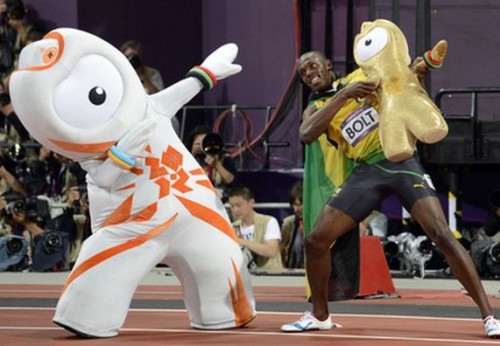
Jamaican runner Usain Bolt strikes his signature lightning bolt pose with Olympic mascot Wenlock and mini-stuffed-Wenlock after winning gold in the 100m.
If you were like me and followed the London 2012 Olympics with great enthusiasm, chances are that you’re feeling a bit of a void in your life now that the Games are over. So here’s a retrospective of a story that NBC didn’t cover: the chocolate Olympics.
Chocolate sponsorship
Kraft/Cadbury was an “official sponsor” and the “official treat provider” for the London games, the only chocolate company allowed that status (Mars was the “official chocolate” of Beijing 2008), and launched a 50 million pound marketing campaign as a result. The campaign included printing the London 2012 logo on Cadbury products, selling chocolates made in the shape of the rather odd Olympic mascots, and crafting a social media strategy to amp up support for Great Britain’s athletes.
In typical Cadbury fashion, the marketing was quirky. The interactive online tool “The Cadbury Choculator” allows users to generate Games statistics in chocolatey measurements. For example, I learned that “The London 2012 Olympic Swimming pool is 208 wonderful Cadbury Dairy Milk bars wide” and “In Olympic Trampolining the gymnasts perform tricks at whopping 500 Cadbury Crunchie bars high.”
Cadbury also returned to its stop motion Crème Egg video style for the Games with an Olympic-themed “Let the Goo Games Begin” campaign:
Other chocolate companies were unofficially involved with the Games, by sponsoring athletes as “brand ambassadors,” setting up treat stands around London, and releasing products in “the spirit of” the Olympics. Regulations around the use of the Olympic symbols are strict, though, and unsanctioned uses, like those of bakers making bagels or cakes displaying the Olympic rings, were subject to accusation of trademark infringement. But, as is often the case, there were ways around the rules, and people who knew where to ask could still find plenty of chocolate diversity thanks to the thriving black market in the Olympic Park.
Chocolate and fitness
One aspect of the chocolate Olympics merits further discussion than it got in the mainstream press this year — the ethics of promoting candy to children, especially when linking it with fitness. While many enjoy debating the efficacy of advertising regulations, there is significant evidence demonstrating the harmful health consequences of advertising to kids. Cadbury seems to have chosen a different strategy this year due to bad press around childhood obesity in the past, focusing its marketing push on game-playing rather than chocolate consumption. Still, plenty of marketing to kids took place during the Olympics and will continue in the future, and some of it included chocolate.
The average person should never model their diet after elite athletes who eat up to 12,000 calories a day to keep up with their workout regime. The vast majority of us simply don’t move around enough to need that much food. It’s therefore all the more unfortunate that the sponsorships elite athletes rely on to support themselves financially so often compromise basic nutritional wisdom. (Even American swimmer and eleven time Olympic medalist Ryan Lochte sought out a healthier training diet after feeling that he could have performed better in the 2008 Beijing Olympics without typical breakfasts of “two or three McDonald’s egg McMuffins, some hashbrowns and maybe a chicken sandwich.”)
Several USA Swimming team members hawk chocolate milk for big bucks from the Refuel With Chocolate Milk campaign. I’d need to swim for 30 minutes to burn off the calories in the average serving of low-fat chocolate milk, and the sugar content is as high as in many sodas. Even beloved Massachusetts-based Team USA gold medal winning gymnast Aly Raisman is selling chocolate milk as “the best combination of carbohydrates and protein” for post-workout muscle recovery. Given the excessive sugar content, poor quality of the chocolate, and the mounting evidence against heavy milk consumption for health, the suggestion that this is an ideal post-workout drink for an average person is absurd.
Olympian love for chocolate
Of course, it wasn’t all marketing and sponsorships at the chocolate Olympics. Several Olympians went on the record about their love for chocolate “just because.” Great Britain’s medal winning triathletes the Brownlee brothers have been inspired by chocolate since childhood, Great Britain’s gold medalist heptathlete Jessica Ennis looks forward to splurging on chocolate on her weekly cheat days during training, the USA’s all around gymnastics gold medalist Gabby Douglas enjoys “all kinds of chocolate,” and India’s medal winning badminton player Saina Nehwal said “I’m going to eat a lot of chocolate now. It’s okay if I put on some weight,” when asked what her plans were after the Games. Team USA’s lightweight rower, Nick LaCava, who is 6’3″ tall and, incredibly, weighs in at 156 pounds on race days, has a chocolate business background. He was a co-founder of customizable chocolate bar company Chocomize before living out his Olympic dream.
Let’s keep it real
The oldest Olympic torch bearer at these Games, 100-year-old Diana Gould, shared the key to long life with the UK’s Telegraph. According to her century of wisdom, one can live a long and happy life with a good attitude, healthy habits that include lots of walking, and a bit of chocolate each day.
Usain Bolt was awarded a huge chocolate bar in the Czech Republic’s Golden Spike athletics event in May 2012 and went on to win three gold medals in the London Olympics (there’s a cute video of tiny children racing against him and then sharing chocolate here). As delicious as that chocolate might have been, it was not responsible for making him the fastest man in the world. Twice. Nor should chocolate companies suggest that it was.
A favorite summer treat: L.A. Burdick’s iced hot chocolate
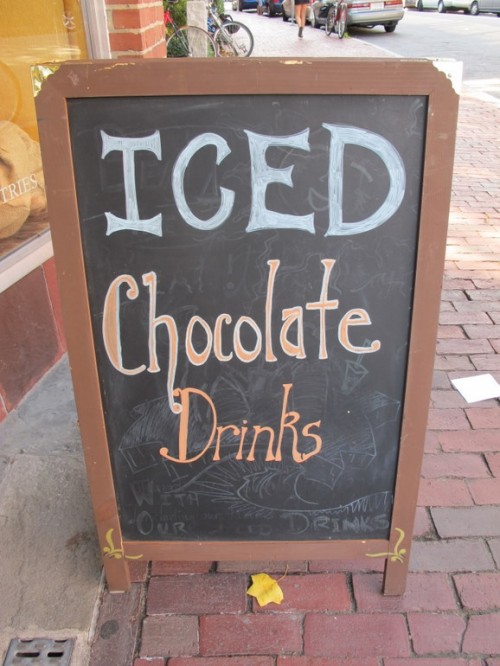
It pains me to acknowledge it, but summer is eventually going to end. In the not distant future, the air will turn crisp and whisper of autumn. But before the last of the hot, sunny days disappear, I’m determined to fit in as much summer fun as possible.
One of my favorite summer treats is iced hot chocolate. For over a decade now, my go-to iced hot chocolate spot has been the L.A. Burdick cafe in Harvard Square in Cambridge, Massachusetts. Burdick uses Valrhona chocolate in their standard chocolate drinks, and more recently has added a line of single source chocolate options. Lately, I’m partial to the Madagascan for drinking; the Burdick menu describes it as “Madagascan: 64% chocolate with a very sharp fruity acidity with hints of citrus and vanilla. Medium body wih a long finish.” Translation: MELTED YUM!
Perhaps the most fun, though, comes in introducing someone to the drink for the first time. Too often my friends and colleagues squeal “Iced hot chocolate?! Who knew? Oh, the deliciousness!” as though their lives have been forever changed by the experience. And I can’t help but chuckle and roll my eyes when I hear the familiar “Iced hot chocolate? Isn’t that an oxymoron?” Poor little rich kids trapped in a literal world…
It’s possible that the literalists are thinking “Isn’t this just… chocolate milk?” In fact, it is so. much. more. Burdick’s prepares the iced hot chocolate by first melting chocolate shavings in steamed or scalded milk, then pouring the hot mixture over ice. They’ll even add whipped cream and a sprinkling of cocoa powder on top, if you fancy. In an epic battle of chocolate milk vs. iced hot chocolate, iced hot chocolate would claim an easy victory. (More on this in a future post.)
I credit the Cambridge L.A. Burdick cafe with introducing me to my first tastes of fine chocolate back when I was just a wee teenage choco fangirl, and for showing me that there was a vast world of flavor to explore. One of my dearest friends worked at the cafe for nearly a decade. Lover of a good story that I am, I relished the opportunity to hear the “backstage” talk at the cafe, from how the chocolates were made to what quirky customers would sometimes say or do. (More on the Burdick company in a future post, too.)
So, if you’re in the Boston area, I highly recommend a trip to Harvard Square to taste this special drink. Good luck resisting the pastries and bonbons while you’re there.
L.A. Burdick Chocolate Cafe
52 Brattle St., Harvard Square
Cambridge, MA 02138
phone: 617-491-4340
Sun-Thurs 8am-9pm
Fri-Sat 8am-10pm
(Burdick also has locations in Walpole, NH and New York, NY)
Or, you can make iced hot chocolate on your own with one of these recipes:
L.A. Burdick’s Iced Hot Chocolate
David Lebovitz’s Iced Chocolate (As a New Englander, I would technically dub this a souped up chocolate frappe because of the ice cream… Eh, technicalities. It is awesome.)
Summer, please stay just a little bit longer.
